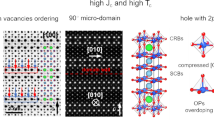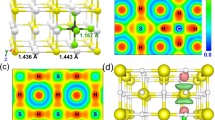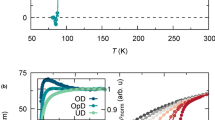Abstract
RECENTLY there has been significant effort directed towards exploring the physical and chemical properties of C60 and other large carbon clusters1–11. Particularly intriguing are reports of superconductivity in potassium- and rubidium-doped C60 crystals and films5–7. The transition temperatures (Tc) for K-doped C60 (18 K) and Rb-doped C60 (∼28 K) are significantly higher than those reported previously for other molecular superconductors12. Earlier attempts to prepare a caesium-doped superconducting phase7 have proved unsuccessful. Here we report that a Cs-doped superconductor can be prepared by using as the dopant binary alloys of the type CsM (where M is Hg, Tl or Bi). We observe a reproducible superconducting transition in CsxC60 (x = 1.2–3) at 30 K, demonstrated by flux expulsion (the Meissner effect) and flux exclusion (shielding) d.c. magnetization measurements. The low superconducting volume fraction (∼1%) suggests that further studies will be needed to determine the optimal doping concentra-tion and to place tighter bounds on Tc.
This is a preview of subscription content, access via your institution
Access options
Subscribe to this journal
Receive 51 print issues and online access
$199.00 per year
only $3.90 per issue
Buy this article
- Purchase on Springer Link
- Instant access to full article PDF
Prices may be subject to local taxes which are calculated during checkout
Similar content being viewed by others
References
Krätschmer, W., Lamb, L. D., Fostiropoulos, K. & Huffman, D. R. Nature 347, 254–358 (1990).
Haufler, R. E. et al. J. phys. Chem. 94, 8634–8636 (1990).
Haddon, R. C. et al. Nature 350, 46–47 (1991).
Haddon, R. C. et al. Nature 350, 320–321 (1991).
Hebard, A. F. et al. Nature 350, 600–601 (1991).
Rosseinsky, M. J. et al. Phys. Rev. Lett. 66, 2830–2832 (1991).
Holczer, K. et al. Science 252, 1154–1157 (1991).
Bausch, J. W., Prakash, G. K. & Olah, G. A. J. Am. chem. Soc. 113, 3205–3206 (1991).
Duclos, S. J., Brister, K. Haddon, R. C., Kortan, A. R. & Thiel, F. A. Nature 351, 380–382 (1991).
Heiney, P. A. et al. Phys. Rev. Lett. 66, 2911–2914 (1991).
Weaver, J. H. et al. Phys. Rev. Lett. 66, 1741–1744 (1991).
Williams, J. M. et al. Inert Chem. 29, 3272–3274 (1990).
Zhou, O. et al. Nature 351, 462–464 (1991).
Stephens, P. W. et al. Nature 351, 632–634 (1991).
Diederich, F. et al. Science 252, 548–551 (1991).
Lagrange, P. J. Mater. Res. 2, 839–845 (1987).
Author information
Authors and Affiliations
Rights and permissions
About this article
Cite this article
Kelty, S., Chen, CC. & Lieber, C. Superconductivity at 30 K in caesium-doped C60. Nature 352, 223–225 (1991). https://doi.org/10.1038/352223a0
Received:
Accepted:
Issue Date:
DOI: https://doi.org/10.1038/352223a0
This article is cited by
-
Superconductivity and correlated phases in non-twisted bilayer and trilayer graphene
Nature Reviews Physics (2023)
-
Complementary doping of van der Waals materials through controlled intercalation for monolithically integrated electronics
Nano Research (2020)
-
First-principle investigation on growth patterns and properties of cobalt-doped lithium nanoclusters
Journal of Molecular Modeling (2016)
-
Nanoscience and the nano-bioelectronics frontier
Nano Research (2015)
-
Observation of a universal donor-dependent vibrational mode in graphene
Nature Communications (2014)
Comments
By submitting a comment you agree to abide by our Terms and Community Guidelines. If you find something abusive or that does not comply with our terms or guidelines please flag it as inappropriate.



